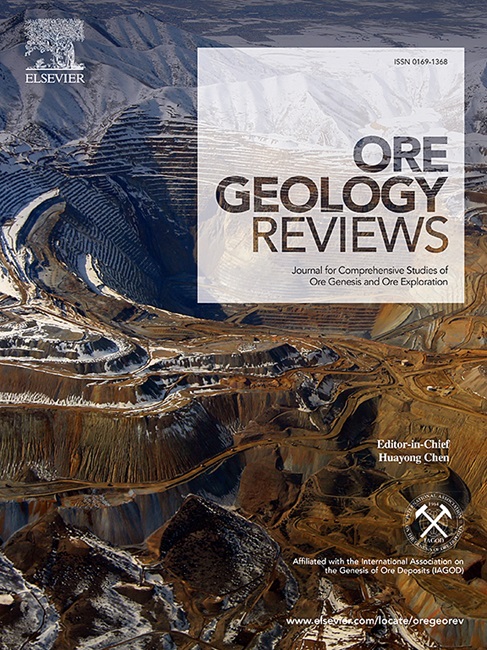加拿大安大略省杰拉尔顿绿岩成因金矿床的地质学:结构控制、矿物学、地球化学和地质年代学
IF 3.2
2区 地球科学
Q1 GEOLOGY
引用次数: 0
摘要
绿岩造山型金矿床位于加拿大阿歇安苏必利尔克拉通的花岗岩-绿岩瓦比贡次省和变质岩奎茨托次省交界处的比尔德莫尔-杰拉尔顿带(BGB)。矿床赋存于约 2700-2694 Ma 的浊积砂岩、带状铁质岩层和约 2694 Ma 的长石-石英斑岩中,这些岩层在沿 BGB 南缘 1 公里宽的 Bankfield-Tombill 变形带内经历了强烈的变形。该变形带包括 BGB 早期 D1 推力叠加期间形成的褶皱和劈裂、D2 正弦转位期间形成的 S 形褶皱和构造,以及变形带 D3 右旋再活化期间形成的 Z 形褶皱、构造和局部剪切带。金矿化与褶皱、早期-D1、石英-碳酸盐矿脉(V1)和东北至东向、同步-D2、电气石-石英矿脉(V2)以及石英-碳酸盐矿脉(V3)有关。V1 和 V3 矿脉周围有绢云母-碳酸盐-黄铁矿±白云石-黄铜矿蚀变晕,V2 矿脉周围有碳酸盐-电气石-黄铁矿±黄铁矿-黄铜矿蚀变晕。金是在流体-岩石硫化反应过程中沉积下来的,这种反应形成了贫包体黄铁矿(Ni-Co-As 主晶分带)和富包体黄铁矿(Ag-As-Bi-Co-Ni-Pb-Sb-Te),后者富含金和其他金属(Ag-As-Bi-Co-Ni-Pb-Sb-Te)。与矿脉沉积相关的热液蚀变产生了一个宽达 250 米的绢云母-碳酸盐蚀变包络,其中 S、Te、As、W 和 Bi 是金矿化的最佳探路指标。以前的研究认为 BGB 金矿床的形成是在 D3 晚期,与此相反,我们的研究结果表明,金矿是在 D1 和 D2 早期形成的,并且在几次变形过程中涉及到多个热液脉冲,这与与主要断层带相关的其他主要 Archean 造山型金矿区(如苏必利尔环形山 Abitibi 子省的 Timmins 和 Kirkland Lake 矿区)的情况一致。本文章由计算机程序翻译,如有差异,请以英文原文为准。

The geology of the Greenstone orogenic gold deposit, Geraldton, Ontario, Canada: Structural controls, mineralogy, geochemistry, and geochronology
The Greenstone orogenic gold deposit is located in the Beardmore-Geraldton belt (BGB) along the boundary between the granite-greenstone Wabigoon subprovince and the metasedimentary Quetico subprovince of the Archean Superior craton, Canada. The deposit is hosted by ca. 2700–2694 Ma turbiditic sandstone, banded iron formation, and ca. 2694 Ma feldspar-quartz porphyry, which underwent strong deformation within the 1 km-wide Bankfield-Tombill deformation zone along the southern margin of the BGB. The deformation zone includes folds and cleavage that formed during early D1 thrust imbrication of the BGB, S-shaped folds and fabrics that formed during D2 sinistral transpression, and Z-shaped folds, fabrics, and localized shear zones that formed during D3 dextral reactivation of the deformation zone. Gold mineralization is associated with folded, early-D1, quartz-carbonate veins (V1) and with NE- to E-striking, syn-D2, tourmaline-quartz veins (V2) as well as quartz-carbonate veins (V3). The V1 and V3 veins are surrounded by sericite-carbonate-pyrite ± albite–rutile alteration halos, and the V2 veins are surrounded by carbonate-tourmaline-pyrite ± pyrrhotite-chalcopyrite alteration halos. Gold was deposited during fluid-rock sulfidation reactions that resulted in the formation of inclusion-poor pyrite with Ni-Co-As primary crystallographic zoning and inclusion-rich pyrite enriched in Au and other metals (Ag-As-Bi-Co-Ni-Pb-Sb-Te). Hydrothermal alteration associated with the deposition of the veins produced a broad, up to 250 m wide, sericite-carbonate alteration envelope, with S, Te, As, W, and Bi as the best pathfinder indicators to gold mineralization. Contrary to previous studies, which attributed the formation of gold deposits in the BGB to late-D3, our results suggest that gold was emplaced during early-D1 and D2 and involved multiple hydrothermal fluid pulses during several deformation events, as suggested for other major Archean orogenic gold camps associated with major fault zones such as the Timmins and Kirkland Lake camps in the Abitibi subprovince of the Superior craton.
求助全文
通过发布文献求助,成功后即可免费获取论文全文。
去求助
来源期刊

Ore Geology Reviews
地学-地质学
CiteScore
6.50
自引率
27.30%
发文量
546
审稿时长
22.9 weeks
期刊介绍:
Ore Geology Reviews aims to familiarize all earth scientists with recent advances in a number of interconnected disciplines related to the study of, and search for, ore deposits. The reviews range from brief to longer contributions, but the journal preferentially publishes manuscripts that fill the niche between the commonly shorter journal articles and the comprehensive book coverages, and thus has a special appeal to many authors and readers.
 求助内容:
求助内容: 应助结果提醒方式:
应助结果提醒方式:


